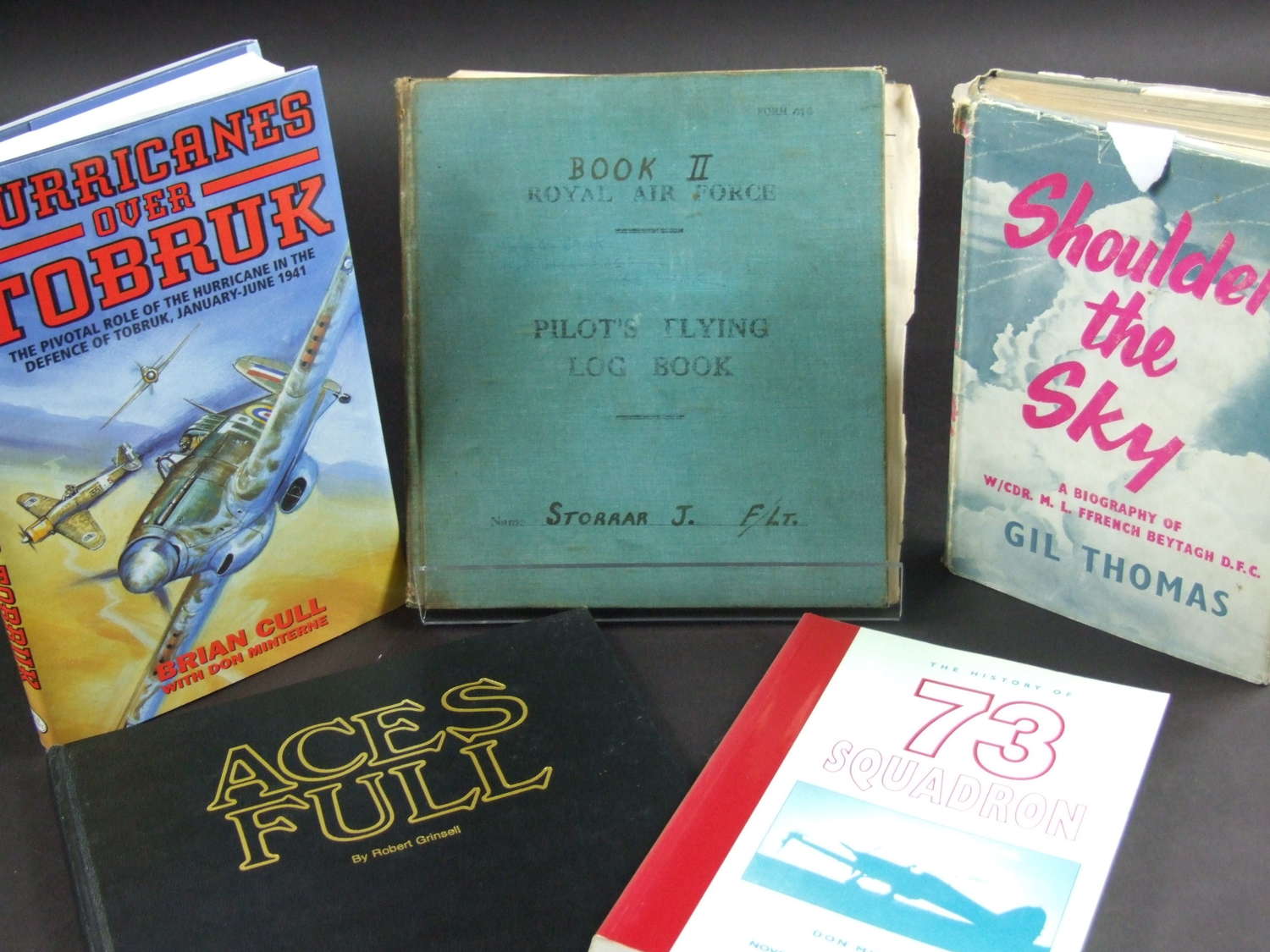






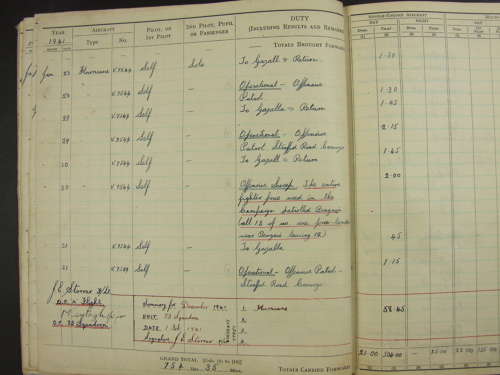




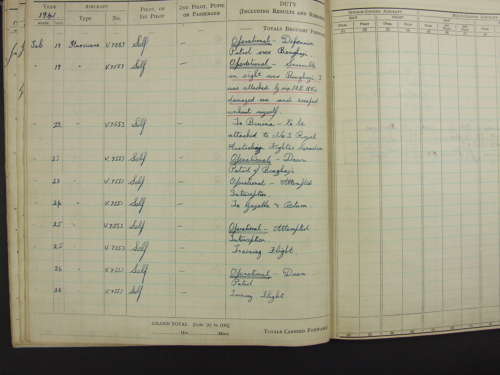


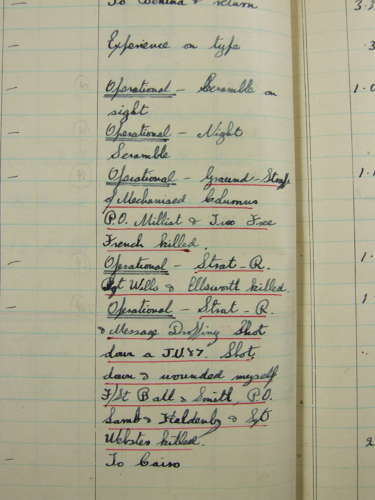


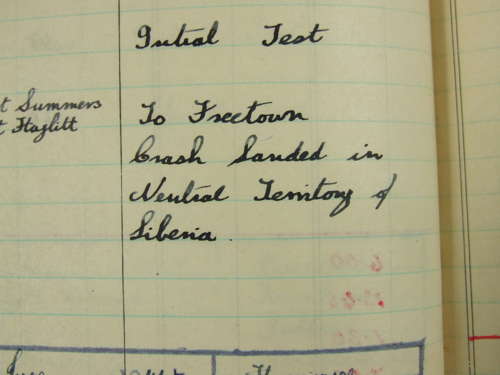


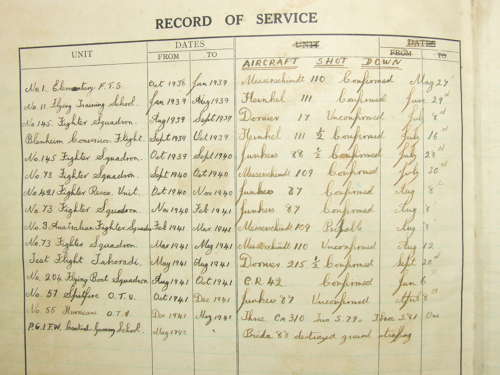

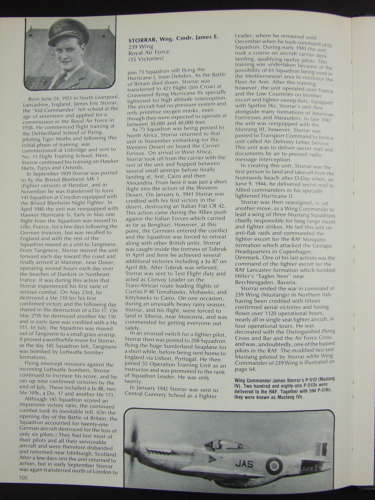
Code: 56485
A Pilot’s Flying Log Book appertaining to noted Fighter Ace, Wing Commander J. E. Storrar, D.F.C. and Bar, A.F.C., Royal Air Force, a remarkable pilot who flew in the Battle of Britain and ended the war with a tally of 12 and 2 shared destroyed, with a further 2 and 1 shared probable, 3 damaged and 1 and 8 shared destroyed
Covering the dates 29 November 1940-22 June 1942, inscribed on the cover Storrar J. F/Lt. Book II contents are generally good with one or two pages damaged.
This is Log Book 2 and covers his time and victories in North Africa along with annotation of notable incidents such as his force landing Liberia and the day in April 1941 when he was himself shot down and wounded.
Whilst RAF Pilots Log Books are rare, those to an Ace, particular one who had become an Ace during the Battle of France and Britain and later in the Western Desert, are virtually unobtainable.
James Eric Storrar was born on 24 July 1921 at Ormskirk, Lancashire and entered the Royal Air Force in 1938. Storrar flew the Hurricanes of No. 145 Squadron during the Battle of Britain and was awarded his D.F.C. in August 1940, having scored four victories in the space of five days during the Battle of France, including two Bf110s over Dunkirk on 27 May. During the period covered in this Log Book, he scored another 4 victories, with a further shared victory, including being shot down and wounded on 8 April 1941, having added a Ju87 to his tally, Storrar was forced to walk some 30 miles to the Allied lines.
Involved in the Defence of Tobruk until his withdrawal on 20 April, he was then rested and posted to Training Units. Taking command of No. 65 Squadron in January 1943, he added a Bar to his decoration having scored five more victories since the first award. Joining the Secret Hurricane Mail Flight, Storrar had the distinction of being the first pilot to take off and land following the Normandy Landings, a feat recorded on D+3.
Miraculously surviving Dunkirk ‘Jas’ continued to have an eventful war. In November 1940 his squadron sailed to Takoradi on the coast of West Africa, aboard the aircraft carrier Furious. It then flew the “stepping stone” route across Africa to Egypt. On one occasion bad weather forced him down in the jungle from where it took him two days and three nights to walk more than 70 miles to the Firestone rubber plantation near Monrovia in Liberia.
A tribute to Jas Storrar, written when he died, highlighted his record of 15 confirmed kills as a pilot in the Battle of Britain as well as describing him as “a giant of a man”. Well over 6ft tall, he was barely able to squeeze into the cockpit of his fighter,” it read. “Over the years he retained something of the flamboyant style of a Battle of Britain pilot. His jackets were lined with red silk and his Jaguar XJS 12 bore the registration JAS.”
A Pilot’s Flying Log Book appertaining to noted Fighter Ace, Wing Commander J. E. Storrar, D.F.C. and Bar, A.F.C., Royal Air Force, a remarkable pilot who flew in the Battle of Britain and ended the war with a tally of 12 and 2 shared destroyed, with a further 2 and 1 shared probable, 3 damaged and 1 and 8 shared destroyed
Covering the dates 29 November 1940-22 June 1942, inscribed on the cover Storrar J. F/Lt. Book II contents are generally good with one or two pages damaged.
This is Log Book 2 and cover his time and victories in North Africa along with annotation of notable incidents such as his force landing Liberia and the day in April 1941 when he was himself shot down and wounded.
Whilst RAF Pilots Log Books are rare, those to an Ace, particular one who had become an Ace during the Battle of France and Britain and later in the Western Desert, are virtually unobtainable.
James Eric Storrar was born on 24 July 1921 at Ormskirk, Lancashire and entered the Royal Air Force in 1938. Storrar flew the Hurricanes of No. 145 Squadron during the Battle of Britain and was awarded his D.F.C. in August 1940, having scored four victories in the space of five days during the Battle of France, including two Bf110s over Dunkirk on 27 May. During the period covered in this Log Book, he scored another 4 victories, with a further shared victory, including being shot down and wounded on 8 April 1941, having added a Ju87 to his tally, Storrar was forced to walk some 30 miles to the Allied lines.
Involved in the Defence of Tobruk until his withdrawal on 20 April, he was then rested and posted to Training Units. Taking command of No. 65 Squadron in January 1943, he added a Bar to his decoration having scored five more victories since the first award. Joining the Secret Hurricane Mail Flight, Storrar had the distinction of being the first pilot to take off and land following the Normandy Landings, a feat recorded on D+3.
Miraculously surviving Dunkirk ‘Jas’ continued to have an eventful war. In November 1940 his squadron sailed to Takoradi on the coast of West Africa, aboard the aircraft carrier Furious. It then flew the “stepping stone” route across Africa to Egypt. On one occasion bad weather forced him down in the jungle from where it took him two days and three nights to walk more than 70 miles to the Firestone rubber plantation near Monrovia in Liberia.
A tribute to Jas Storrar, written when he died, highlighted his record of 15 confirmed kills as a pilot in the Battle of Britain as well as describing him as “a giant of a man”. Well over 6ft tall, he was barely able to squeeze into the cockpit of his fighter,” it read. “Over the years he retained something of the flamboyant style of a Battle of Britain pilot. His jackets were lined with red silk and his Jaguar XJS 12 bore the registration JAS.”
In 1944 Jas was offered an extended commission but opted instead to study veterinary science at Edinburgh University. He later joined the family parctice, which is still going straong on Tarvin Road in Chester with the sixth generation of Storrar vets continuing to take care of Chester's pets.
13.01.1939 ab initio course, No. 1 Elementary & Reserve Flying Training School (Hatfield)
01.04.1939 commissioned, RAF (General Duties Branch) [short service commission]
15.04.1939 - 23.10.1939 No. 12 Course, No. 11 Flying Training School (Shawbury) [from 08.1939 with Blenheim Conversion Flight]
23.10.1939 - 27.09.1940 145 Squadron RAF (Croydon) (DFC)
28.09.1940 - 05.1941 73 Squadron RAF (Castle Camps, then Middle East) [20-25.10.1940 detached to 421 Flight]
05.1941 - 11.1941 No. 1 Test Flight RAF
11.1941 - 01.1943 returned to UK & posted to 55 Operational Training Unit RAF (Annan) (as Officer Commanding Gunnery Training Squadron)
23.01.1943 transferred, Reserve of Air Force Officers (and called up for Air Force service)
01.1943 - 14.11.1943 Commanding Officer, 65 Squadron RAF (Drem) (Bar to DFC)
15.11.1943 - 04.1944 53 Operational Training Unit RAF (as air-firing instructor; from 12.1943 Chief Flying Instructor)
04.1944 - 10.1944 1697 ADLS Flight
10.1944 - 11.1944 Commanding Officer, 64 Squadron RAF
11.1944 - 01.1945 Commanding Officer, 165 Squadron RAF
01.1945 - 03.1945 Commanding Officer, 234 Squadron RAF
03.1945 - 08.1945 Wing Commander Flying at Hunsdon, Digby & Molesworth
08.1945 - 01.1946 staff job at HQ 12 Group RAF
01.1946 - 04.1947 Commanding Officer, 239 Wing RAF (Desert Air Force, Italy)
25.06.1949 commissioned, RAuxAF (Reconstituted) (General Duties Branch)
25.06.1949 - 24.03.1952 603 Squadron RAuxAF
25.03.1952 - 11.03.1957 Commanding Officer, 610 (County of Chester) Squadron RAuxAF
11.03.1957 transferred to reserve
(A) P/O (prob) 01.04.1939 [41881]
P/O (prob) 23.10.1939
P/O 23.01.1940
F/O 23.10.1940
(WS) F/Lt. 23.10.1941
(A) Sq.Ldr. (1943)
(WS) Sq.Ldr. 21.07.1945
(T) Sq.Ldr. 03.12.1946, seniority 01.01.1946 (reld 25.06.1949; retaining rank of W/Cdr.)
F/O 25.06.1949, seniority 20.12.1948
F/Lt. 01.04.1950, seniority 25.07.1949
Sq.Ldr. 25.03.1952 (reld 25.06.1959)
DFC 20.08.1940 *
DFC 29.10.1943 ?
AFC 01.01.1955 ?
MID 02.06.1943 ?
* This officer took part in the intensive fighting over Dunkirk last May, and has since been engaged in numerous successful actions. His squadron was responsible for the destruction of twenty-one enemy aircraft in one day; he personally destroyed two of these. Pilot Officer Storrar has displayed an unfailing desire to engage the enemy at all times and has shot down eight enemy aircraft.
Included with the Log Book are four recent publication all making reference to James Storrar.
23.01.1939 ab initio course, No. 1 Elementary & Reserve Flying Training School (Hatfield)
01.04.1939 commissioned, RAF (General Duties Branch) [short service commission]
15.04.1939 - 23.10.1939 No. 12 Course, No. 11 Flying Training School (Shawbury) [from 08.1939 with Blenheim Conversion Flight]
23.10.1939 - 27.09.1940 145 Squadron RAF (Croydon) (DFC)
28.09.1940 - 05.1941 73 Squadron RAF (Castle Camps, then Middle East) [20-25.10.1940 detached to 421 Flight]
05.1941 - 11.1941 No. 1 Test Flight RAF
11.1941 - 01.1943 returned to UK & posted to 55 Operational Training Unit RAF (Annan) (as Officer Commanding Gunnery Training Squadron)
23.01.1943 transferred, Reserve of Air Force Officers (and called up for Air Force service)
01.1943 - 14.11.1943 Commanding Officer, 65 Squadron RAF (Drem) (Bar to DFC)
15.11.1943 - 04.1944 53 Operational Training Unit RAF (as air-firing instructor; from 12.1943 Chief Flying Instructor)
04.1944 - 10.1944 1697 ADLS Flight
10.1944 - 11.1944 Commanding Officer, 64 Squadron RAF
11.1944 - 01.1945 Commanding Officer, 165 Squadron RAF
01.1945 - 03.1945 Commanding Officer, 234 Squadron RAF
03.1945 - 08.1945 Wing Commander Flying at Hunsdon, Digby & Molesworth
08.1945 - 01.1946 staff job at HQ 12 Group RAF
01.1946 - 04.1947 Commanding Officer, 239 Wing RAF (Desert Air Force, Italy)
25.06.1949 commissioned, RAuxAF (Reconstituted) (General Duties Branch)
25.06.1949 - 24.03.1952 603 Squadron RAuxAF
25.03.1952 - 11.03.1957 Commanding Officer, 610 (County of Chester) Squadron RAuxAF
11.03.1957 transferred to reserve
(A) P/O (prob) 01.04.1939 [41881]
P/O (prob) 23.10.1939
P/O 23.01.1940
F/O 23.10.1940
(WS) F/Lt. 23.10.1941
(A) Sq.Ldr. (1943)
(WS) Sq.Ldr. 21.07.1945
(T) Sq.Ldr. 03.12.1946, seniority 01.01.1946 (reld 25.06.1949; retaining rank of W/Cdr.)
F/O 25.06.1949, seniority 20.12.1948
F/Lt. 01.04.1950, seniority 25.07.1949
Sq.Ldr. 25.03.1952 (reld 25.06.1959)
DFC 20.08.1940 *
DFC 29.10.1943 ?
AFC 01.01.1955 ?
MID 02.06.1943 ?
* This officer took part in the intensive fighting over Dunkirk last May, and has since been engaged in numerous successful actions. His squadron was responsible for the destruction of twenty-one enemy aircraft in one day; he personally destroyed two of these. Pilot Officer Storrar has displayed an unfailing desire to engage the enemy at all times and has shot down eight enemy aircraft.
Included with the Log Book are four recent publication all making reference to James Storrar.